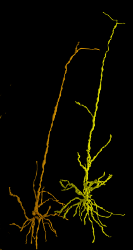Welcome to the Allen SDK¶
The Allen Software Development Kit houses source code for reading and processing Allen Brain Atlas data. The Allen SDK focuses on the Allen Brain Observatory, Cell Types Database, and Mouse Brain Connectivity Atlas.
Attention
We will be dropping for py2 support in October 2019, and any files with a py2 dependency (for example analysis files) will also be updated.

Allen Brain Observatory¶
The Allen Brain Observatory is a data resource for understanding sensory processing in the mouse visual cortex. This study systematically measures visual responses in multiple cortical areas and layers using two-photon calcium imaging of GCaMP6-labeled neurons targeted using Cre driver lines. Response characterizations include orientation tuning, spatial and temporal frequency tuning, temporal dynamics, and spatial receptive field structure.
The mean fluorescence traces for all segmented cells are available in the Neurodata Without Borders file format (NWB files). These files contain standardized descriptions of visual stimuli to support stimulus-specific tuning analysis. The Allen SDK provides code to:
- download and organize experiment data according to cortical area, imaging depth, and Cre line
- remove the contribution of neuropil signal from fluorescence traces
- access (or compute) dF/F traces based on the neuropil-corrected traces
- perform stimulus-specific tuning analysis (e.g. drifting grating direction tuning)

Allen Cell Types Database¶
The Allen Cell Types Database contains electrophysiological and morphological characterizations of individual neurons in the mouse primary visual cortex. The Allen SDK provides Python code for accessing electrophysiology measurements (NWB files) for all neurons and morphological reconstructions (SWC files) for a subset of neurons.
The Database also contains two classes of models fit to this data set: biophysical models produced using the NEURON simulator and generalized leaky integrate and fire models (GLIFs) produced using custom Python code provided with this toolkit.
The Allen SDK provides sample code demonstrating how to download neuronal model parameters from the Allen Brain Atlas API and run your own simulations using stimuli from the Allen Cell Types Database or custom current injections:

Allen Mouse Brain Connectivity Atlas¶
The Allen Mouse Brain Connectivity Atlas is a high-resolution map of neural connections in the mouse brain. Built on an array of transgenic mice genetically engineered to target specific cell types, the Atlas comprises a unique compendium of projections from selected neuronal populations throughout the brain. The primary data of the Atlas consists of high-resolution images of axonal projections targeting different anatomic regions or various cell types using Cre-dependent specimens. Each data set is processed through an informatics data analysis pipeline to obtain spatially mapped quantified projection information.
The Allen SDK provides Python code for accessing experimental metadata along with projection signal volumes registered to a common coordinate framework. This framework has structural annotations, which allows users to compute structure-level signal statistics.
See the mouse connectivity section for more details.
What’s New - Release 1.0.0 (October 3, 2019)¶
The 1.0.0 release brings support for the Allen Brain Observatory - Visual Coding Neuropixels dataset! This dataset is a large-scale extracellular electrophysiological survey of mouse subcortical visual cortical regions using high-density neuropixels probes. To get started with these data, take a look at the quick start guide (download .ipynb), and full example notebook (download .ipynb).
We have implemented new and improved eye-tracking methods based on Deep Lab Cut. These eye tracking results can be accessed for existing brain observatory experiments by calling get_ophys_eye_gaze_data on a BrainObservatoryCache object. For Neuropixels sessions, you can access these data by calling get_eye_tracking_data on an EcephysSession object.
With this release, we are no longer supporting Python 2.